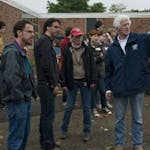Immediately upon finishing Raynor Winn's 2019 memoir, "The Salt Path," I went to the computer and called up Google. "What happened to Moth?" I typed. I needed to know; in the course of reading that powerful book, Winn and her husband, Moth Walker, had become important to me.
Winn's gorgeous new memoir, "The Wild Silence," answers that question and does a whole lot more, exploring love, the importance of nature and the meaning of home.
In the first book, Raynor and Moth had lost their farm and savings due to the treachery of a friend. Shortly thereafter, Moth was diagnosed with corticobasal degeneration, a rare terminal illness that shuts down the brain, bit by bit. Doctors told him he didn't have long to live, and they warned him not to exert himself.
Instead, with no money and nowhere to live, the pair set out to hike and camp along England's rugged 630-mile South West Coast Path. The arduous trip seemed to arrest Moth's disease, even make him stronger.
"The Salt Path" is a glorious book, a classic journey tale, a treatise on homelessness, a paean to the beauty and healing of nature, a page-turning adventure. It was an international bestseller and a finalist for a Costa Book Award.
Winn's new memoir, "The Wild Silence," is both sequel and prequel. When it opens, she and Moth have completed their journey and are living in a small apartment in a village in Cornwall. Moth is attending the university, studying for a horticulture degree, but his health is deteriorating again and Raynor is struggling. She misses the connection with nature so desperately that she erects their backpacking tent in the middle of the apartment and crawls inside. Since leaving the coastal path, their lives are failing.
"The Wild Silence" is less adventure narrative and more interior than her first book, but it is just as moving and beautifully written. Once again, Winn's connection to nature and to Moth are at its heart.
"Silence" delves into the past — Winn's childhood on the farm with a mother who was not much like her. ("Even in the potato fields she'd worn a headscarf over hair fixed with hair spray.") It explores the beginning of Raynor and Moth's relationship, how hiking and mountain climbing were fundamental to who they were and how they communicated.
And it takes their story forward, to the writing of "The Salt Path," intended as a love letter to Moth, whose memory was failing and who couldn't remember details of the journey. This Raynor could not bear. "I could write myself onto the Coast Path and in doing so put Moth right there next to me, so when he read it he wouldn't just hear the wind, he'd feel it."
The publication of the book changed their lives. It brought them a much-needed income, and it attracted a Londoner named Sam who owned an ancient apple orchard in Cornwall. The orchard's soil had been depleted to the point where nothing lived, and Sam was determined to find someone to restore the land.
"I loved 'The Salt Path' so much," he told them. "I read it and knew immediately that you were the ones, you would understand."
Life on the apple farm required the intensely physical, outdoors work that Raynor is convinced will help Moth — and herself. "I needed the safety of being one with the land," she writes. "Without it I would never be whole."
"The Wild Silence" is deeply reflective; Winn is a firm believer that physical activity in the out-of-doors is crucial for any human to thrive. When, she wonders, did people become so detached from the natural world?
"At what point in our lives does cynicism take over from instinct?" she writes. "When [did] we stop feeling the softness of the rain on our face and start worrying about being wet?"
Read this lovely book. Go to Google and check on Moth. And then go outside and take a walk.
Laurie Hertzel is the senior editor of books at the Star Tribune. @StribBooks
The Wild Silence
By: Raynor Winn.
Publisher: Penguin Books, 288 pages, $17.







